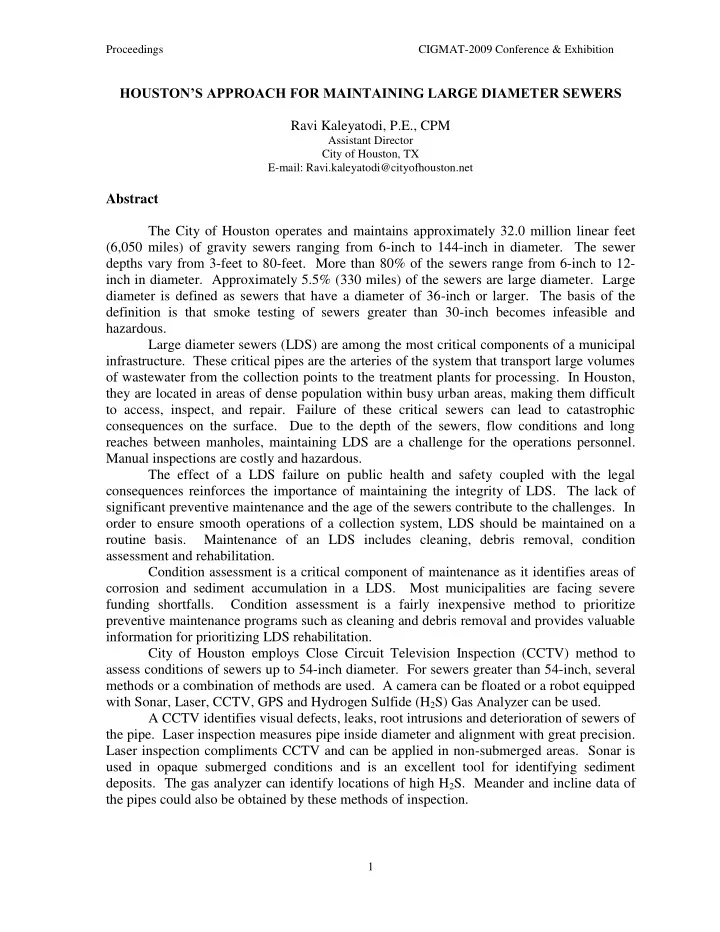

Proceedings CIGMAT-2009 Conference & Exhibition HOUSTON’S APPROACH FOR MAINTAINING LARGE DIAMETER SEWERS Ravi Kaleyatodi, P.E., CPM Assistant Director City of Houston, TX E-mail: Ravi.kaleyatodi@cityofhouston.net Abstract The City of Houston operates and maintains approximately 32.0 million linear feet (6,050 miles) of gravity sewers ranging from 6-inch to 144-inch in diameter. The sewer depths vary from 3-feet to 80-feet. More than 80% of the sewers range from 6-inch to 12- inch in diameter. Approximately 5.5% (330 miles) of the sewers are large diameter. Large diameter is defined as sewers that have a diameter of 36-inch or larger. The basis of the definition is that smoke testing of sewers greater than 30-inch becomes infeasible and hazardous. Large diameter sewers (LDS) are among the most critical components of a municipal infrastructure. These critical pipes are the arteries of the system that transport large volumes of wastewater from the collection points to the treatment plants for processing. In Houston, they are located in areas of dense population within busy urban areas, making them difficult to access, inspect, and repair. Failure of these critical sewers can lead to catastrophic consequences on the surface. Due to the depth of the sewers, flow conditions and long reaches between manholes, maintaining LDS are a challenge for the operations personnel. Manual inspections are costly and hazardous. The effect of a LDS failure on public health and safety coupled with the legal consequences reinforces the importance of maintaining the integrity of LDS. The lack of significant preventive maintenance and the age of the sewers contribute to the challenges. In order to ensure smooth operations of a collection system, LDS should be maintained on a routine basis. Maintenance of an LDS includes cleaning, debris removal, condition assessment and rehabilitation. Condition assessment is a critical component of maintenance as it identifies areas of corrosion and sediment accumulation in a LDS. Most municipalities are facing severe funding shortfalls. Condition assessment is a fairly inexpensive method to prioritize preventive maintenance programs such as cleaning and debris removal and provides valuable information for prioritizing LDS rehabilitation. City of Houston employs Close Circuit Television Inspection (CCTV) method to assess conditions of sewers up to 54-inch diameter. For sewers greater than 54-inch, several methods or a combination of methods are used. A camera can be floated or a robot equipped with Sonar, Laser, CCTV, GPS and Hydrogen Sulfide (H 2 S) Gas Analyzer can be used. A CCTV identifies visual defects, leaks, root intrusions and deterioration of sewers of the pipe. Laser inspection measures pipe inside diameter and alignment with great precision. Laser inspection compliments CCTV and can be applied in non-submerged areas. Sonar is used in opaque submerged conditions and is an excellent tool for identifying sediment deposits. The gas analyzer can identify locations of high H 2 S. Meander and incline data of the pipes could also be obtained by these methods of inspection. 1
Proceedings CIGMAT-2009 Conference & Exhibition City of Houston recently completed several projects using a combination of methods. The following case studies will be discussed during the presentation: Condition assessment of the Northside Sewer Relief Tunnel (NSRT) using a combination of CCTV, Laser, Sonar and Gas Analyzer methods. The Southwest trunk (36-inch to 72-inch) located between Chimney rock and I-610 was assessed for corrosion and odor problems. Scott trunk line (54-inch) in the Sims Bayou Service area was assessed for debris accumulation. The City of Houston employs several methods for the rehabilitation of LDS. They are: Slip Lining – 36-inch to 144-inch diameter Cured-in-Place Piping – 36-inch to 78-inch diameter Grout-in-Place Liners – 48-inch and greater Remove and Replace – All size ranges 2
Proceedings CIGMAT-2009 Conference & Exhibition Slip Lining Cured-In-Place Grout-In-Place Advantages and disadvantages of each method and case studies will be discussed during the presentation. The City plans to invest millions of dollars on LDS assessment and renewal in the next several years. A brief overview of the following planned projects will be discussed: Rehabilitation of NSRT – $25.0 Million in the next 5 years Lyerly Relief Tunnel – $5.0 Million in the next 2 to 3 years Large Diameter Sewer Rehabilitation Program – $7.0 Million/year 3
Recommend
More recommend